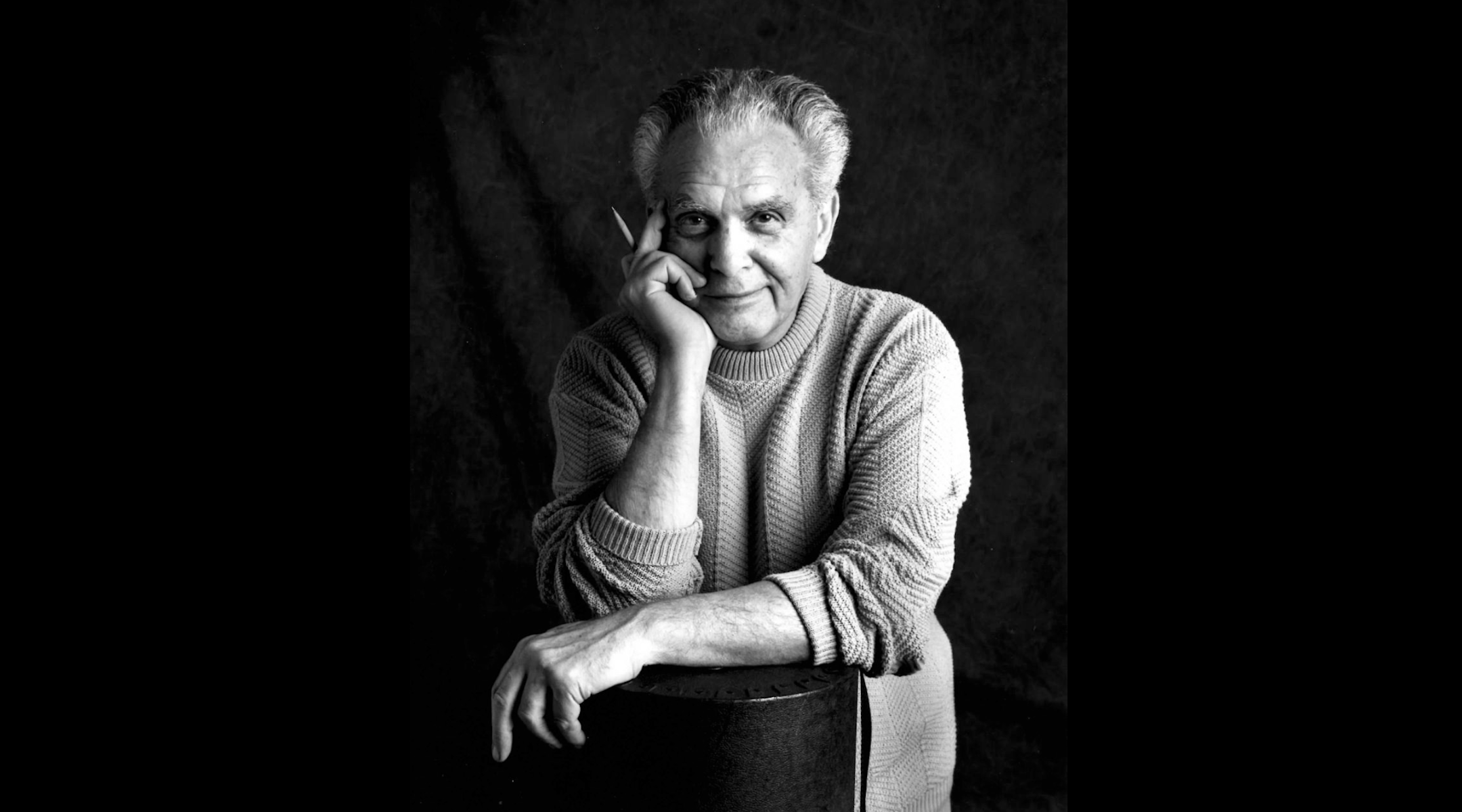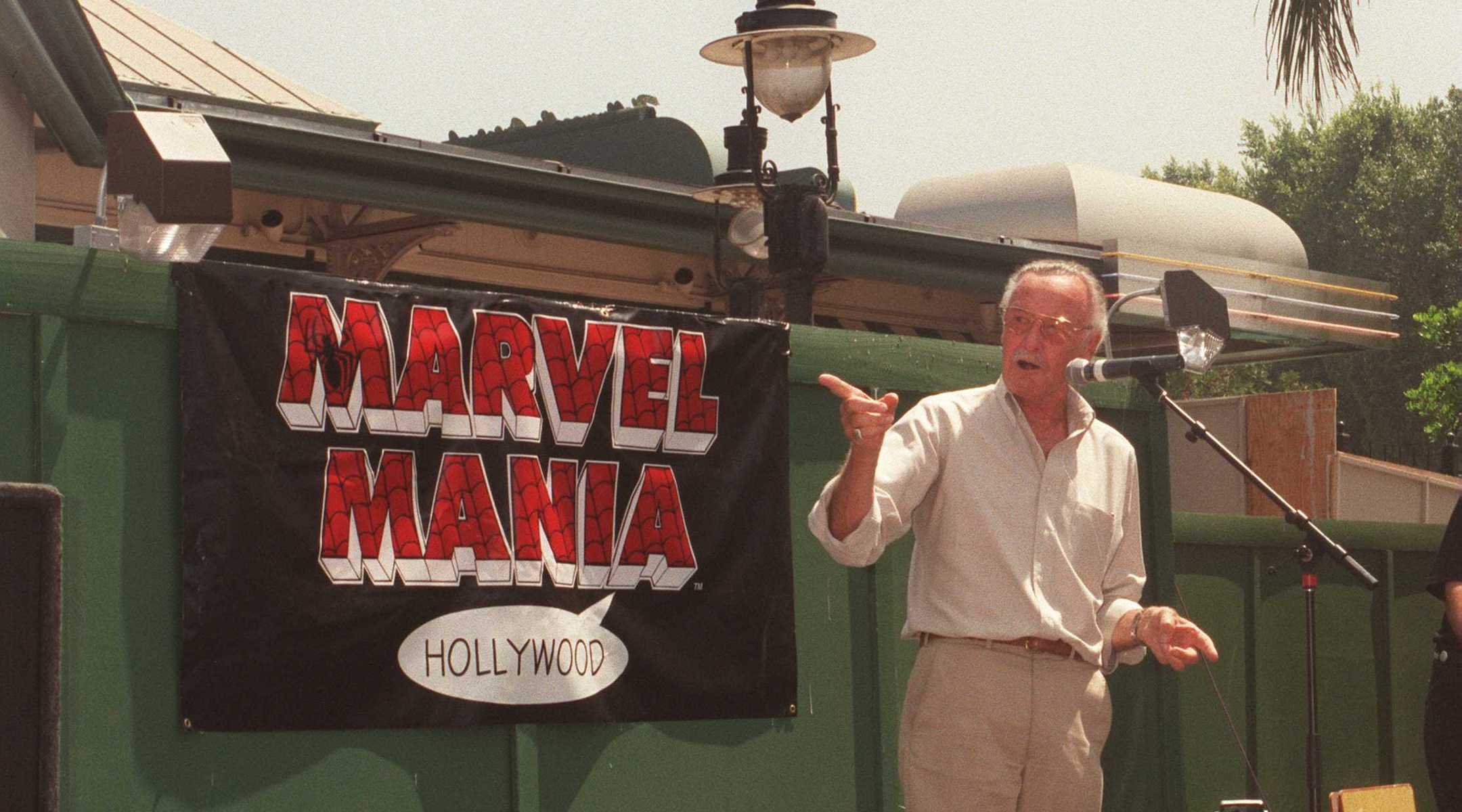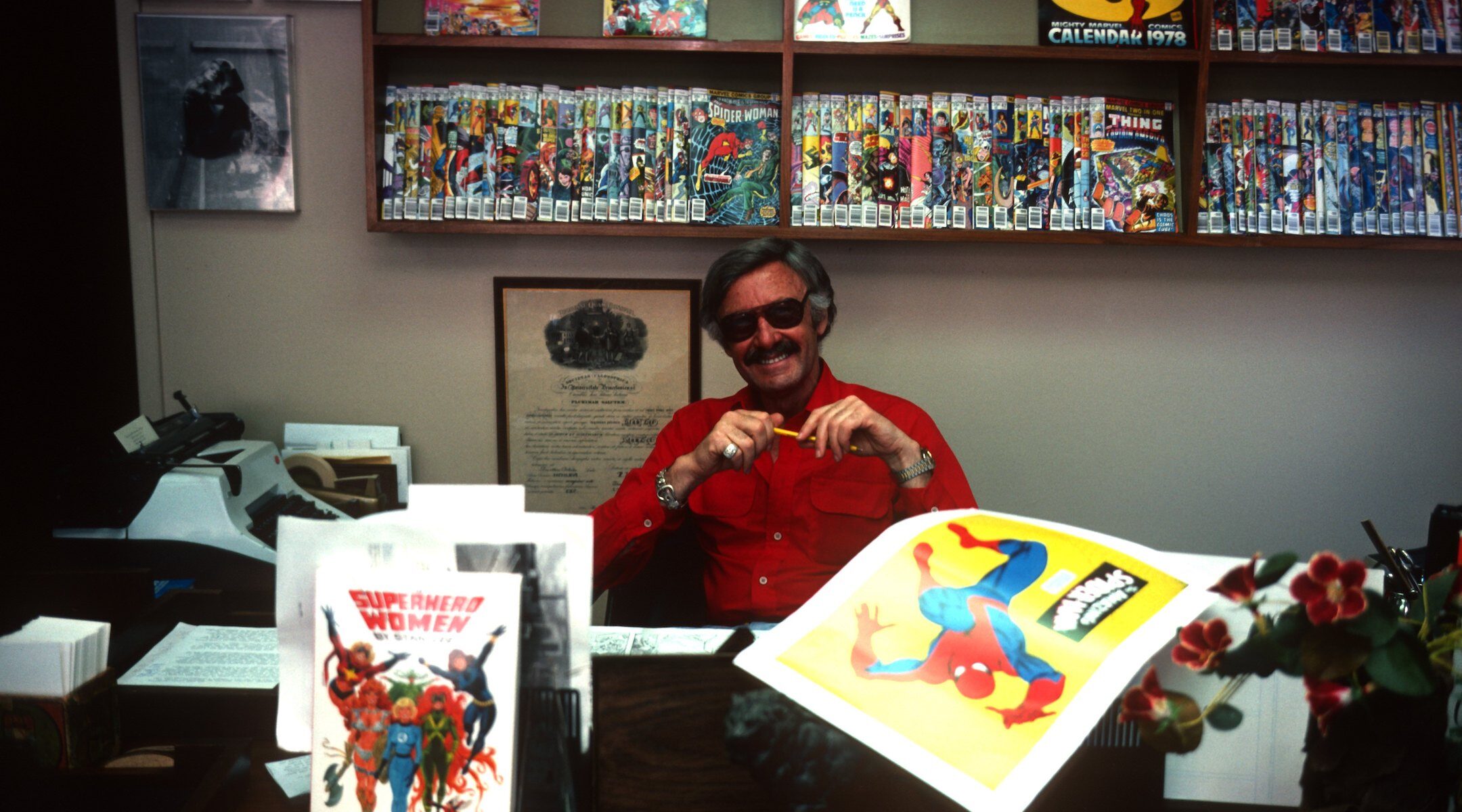(JTA) — Stan Lee, arguably the most famous American comic book creator, died at age 95 in 2018. Honoring his Jewish identity, many evoked the phrase “may his memory be a blessing” (coming from the Hebrew “zichrono l’bracha”) when reporting on his passing.
Just what this memory looks like, however, and what it should look like, is a topic that is increasingly up for debate.
To most people with a passing knowledge of comic books, Lee — who may be best known to the general public for his 30-plus cameos in the many Marvel superhero movies — is believed to be one of the most creative figures in American popular culture. He’s considered the Walt Disney of superheroes, so to speak. But for a small, increasingly vocal faction of comic book aficionados, many of them fans of the legendary Jewish illustrator Jack Kirby, he was an attention-hungry self-promoter, a super-villain who screwed over his creative collaborators.
Since his passing, three new books have been added to the already crowded canon of Stan Lee biographies, exploring his legacy in different ways. The first one was “A Marvelous Life” (St. Martin’s Press, 2019) by former Marvel writer and editor Danny Fingeroth. Last year, Tablet writer Liel Leibovitz published “Stan Lee: A Life in Comics” (Yale University Press, 2020). And this week, “True Believer: The Rise and Fall of Stan Lee” by Abraham Riesman (Crown Publishing) hit the bookshelves. While the first two biographies did what is done again and again with superhero narratives — retelling and reinventing existing myths and origin stories — Riesman’s meticulously researched book, which focuses on Lee’s later years, casts a shadow on the star’s legacy.
His story did not always seem headed this way.
Lee was born Stanley Martin Lieber in New York City in 1922 to Jewish immigrants from Romania. A child of the Great Depression, he witnessed his parents’ financial struggle to make ends meet for the family. Marked by this experience, like many people in this generation, he became a nonstop hustler.
The family first lived on Manhattan’s Upper West Side, then in Washington Heights. Later, they moved further uptown to the Bronx, where he attended DeWitt Clinton High School. He graduated in 1939, the year two other recent Jewish DeWitt Clinton alumni, Bill Finger and Bob Kane, debuted the “Batman” character in Detective Comics (today’s DC Comics).
“Batman” was part of a growing trend initiated by another dynamic Jewish creator duo, Jerry Siegel and Joe Shuster, whose “Superman,” published a year earlier, became a surprising success and consequently the blueprint for a new genre: superheroes.
Two Jewish immigrants from New York City’s Lower East Side — Harry Donenfeld, who was from Romania, like the Liebers, and business partner Jack Liebowitz, born in today’s Ukraine — were the ones who agreed to publish “Superman” for the National Allied Publications imprint.
“Superman” became extremely popular, and, more significantly, profitable, selling hundreds of thousands of issues each month. Not convinced that the success would last, Donenfeld and Leibowitz wanted to cash in while they could and introduced a number of other characters, including the aforementioned “Batman.” Rival companies, eager to emulate the success, created their own superheroes. Among them was also Martin Goodman, a veteran pulp magazine publisher and a relative of Lieber’s mother.
Not sure what else to do after graduation, Stanley joined Timely, the comic book division of his relative’s publishing company. Initially he worked as an errand boy, fetching sandwiches for Timely’s editor Joe Simon, who eventually gave Lieber his first professional writing gig, a rather unremarkable plot point with historic value: When allowed to write, Stanley became Stan Lee.
(Taking on less Jewish sounding pen and stage names was not uncommon for this generation. Hollywood’s biggest star at the time was a Jewish kid from the Lower East Side by the name of Jacob Garfinkle who took on the all-American name John Garfield. Even if the less glamorous comic book business was, as a result of discrimination in more established industries, initially dominated by Jewish publishers, illustrators, writers and editors, several pioneers took on pen names, among them publisher M.C. Gaines, born Max Ginzberg; Batman co-creator Bob Kane, born Robert Kahn; and most prominently Jack Kirby, who grew up on the Lower East Side as Jacob Kurtzberg.)
Lee himself later claimed that he took on a nom de plume because he wanted to save his real name for the great American novel he was planning to write one day. The novel never came, but the pseudonym remained and was later adopted as his legal name.
After the Superman creators Siegel and Shuster, Simon and Kirby were the most prominent duo in the comic book industry. For their “Captain America Comics” series, they negotiated an unheard deal with Goodman that made even the Superman creators jealous. However, as it was common in the industry, the publisher cheated the creators out of their share of profits. Kirby and Simon, for their part, felt that they owed the publisher no loyalty and had been moonlighting for other publishers, which led to them being fired. How Goodman found out about this was never revealed, but Kirby was convinced that Lee betrayed them.
Kirby’s and Simon’s departure from Timely meant that they walked away from “Captain America,” and all the attached royalties.

Jack Kirby in 1993. (Susan Skaar/Kirby Museum/Wikimedia Commons)
After the departure of Kirby and Simon, Lee took over as editor of Timely, which later became Marvel Comics. He was only 19 years old, and this would be, in some form or another, his only job for the rest of his life. As Riesman shows in his book, this was not by choice. Lee tried again and again to branch out to other departments of Goodman’s publishing empire and become a more “serious” writer. Lee was embarrassed to still be working in pulpy kids’ entertainment, a field he had only entered due to a family connection. On a personal level, however, there was some change: he married, moved to the suburbs of Long Island and had a child.
After public opinion turned on comics, which became seen as dangerous poison for youth — thanks in part to the writings of Jewish psychiatrist Frederic Wertham — many series were canceled and several industry pioneers were out of jobs. Kirby ended up crawling back to Lee’s operation, now called Marvel Comics, in the late 1950s, despite despising him.
Lee and Kirby worked on a number of insignificant comics and then, so the story goes, Lee had a midlife crisis that led to the creation of a new approach to the genre: superheroes with human problems. This comic book revolution started with the 1961 debut of “The Fantastic Four,” and over the course of the next few years, Lee and Kirby collaborated on a who’s who of today’s iconic characters such as Thor, Hulk, X-Men and Black Panther. In addition, with illustrator Steve Ditko, Lee collaborated on probably his most famous character, Spider-Man, a modern spin on the old Superman/Clark Kent blueprint.
Marvel soon became the industry leader, thanks in part to Lee’s persistent marketing, which included adding shout-outs in the comic pages to the artists; celebrating himself via his “Stan’s Soapbox” column in the comic books and engaging with fans in other ways. As interest in Marvel grew beyond the comic book world, the media savvy Lee positioned himself as the mastermind of the operation. By all accounts, he was a hands-off boss, outlining a very general plot and allowing the artists to drive the storytelling, filling out text boxes and speech bubbles at the end, a process later known as the “Marvel Method.”
While Lee enjoyed the spotlight and his public persona, many tensions simmered. Riesman describes how Lee’s own brother, Larry Lieber, the co-creator of Iron Man and a few other Marvel superheroes, struggled to pay rent while his brother ascended in the company’s hierarchy. Kirby was angered by the expansion of Marvel to toys, children’s clothing and other items based on his illustrations. As a freelance artist, he received no royalties from these spin-off products. He and Ditko eventually left the company, bitter, fighting for credit, original artwork and money they believed they were owed until the end of their lives.
Then, in a kind of Shakespearean intrigue, Lee outmaneuvered Martin Goodman and his son, taking over Marvel. Goodman consequently created a rival company and employed Ditko and Lieber to compete with Marvel. The venture failed and only increased the rift between Lee and his younger brother.
In the 1980s, Stan Lee left New York for Los Angeles, where he lived for the rest of his life. Most biographies see Lee’s departure from the day-to-day comic business as the epilogue to their narratives, arguing that there were no significant contributions and even some embarrassing ventures, such as “Stripperella,” a series about an exotic dancer turned busty superhero. But Riesman details the last 40 years of Lee’s career as a way to understand his dealings at Marvel.
Lee initially hoped to bring his co-creations to Hollywood, but the venture mostly failed. Meanwhile in New York, Ron Perelman, an investment banker, hatched a plan to separate Marvel’s superheroes into individual intellectual properties, each with market values beyond the comic books. A Washington Post article from 1991 called Perelman the “incredible Hulk of investing.”
But like the incredible Hulk himself, this venture was erratic and the transformation eventually failed, as Dan Raviv detailed in his 2002 book “Comic Wars: How Two Tycoons Battled Over the Marvel Comics Empire – And Both Lost.” Perelman overvalued the intellectual properties and tried to raise money against them. In 1996, Marvel declared bankruptcy and around a third of its staff was terminated. Being the hustler that he was, Lee, however, managed to negotiate a new lucrative contract, securing his position as the company’s figurehead.
The bankruptcy allowed for a fresh start, but Marvel needed money. Licensing deals were made with 20th Century Fox and Sony, soon bringing the company’s intellectual properties to the big screen, starting with “Blade” in 1998, a moderate success, and continuing in 2000 with “X-Men,” which included Stan Lee’s first big screen cameo. Then, in 2002, Sam Raimi’s “Spider-Man” movie reportedly grossed over $400 million.
While Lee had no involvement with these films except for his cameos, he decided to benefit from this new trend and launched Stan Lee Media, a short-lived start-up that lost millions of dollars. It became the subject of an SEC securities fraud investigation and led to convictions for some of Lee’s dubious business partners.
Lee’s next venture, POW Entertainment, was a similarly disastrous misadventure and, according to Riesman, “a largely criminal enterprise.” Lee claimed that he solely gave his name to these enterprises and that he was not involved or aware of the day-to-day operations. He did, however, contribute to the hype by talking about grand projects that fueled the fraud, most of which never made it past their announcements.
Riesman’s reconstruction of Lee’s dubious financial business ventures are more interesting than the outdated superhero concepts they tried to sell, and he seems to present them as central in understanding who Stan Lee really was, consequently giving the reader a better idea of the realities at Marvel decades earlier.
As the Marvel movies exploded into international blockbusters, comic book conventions became increasingly pop culture entertainment shows, focusing on the movie stars depicting the superheroes rather than comic book creators themselves. Lee, always present at them, became a global celebrity, appearing in packed convention rooms, telling humorous anecdotes about his life in comics, cementing his own position. He was the charming old grandfather of comic books, and since most of the pioneers had been dead by the time the Marvel Cinematic Universe began to dominate Hollywood, he became the last connection to the early days of the industry.

Stan Lee at the Marvel Mania restaurant at Universal City Hollywood in 1997. Lee cultivated his public persona through comic cons and other events. (Albert Ortega/Getty Images)
However, many of his stories were false — ranging from one about “winning” a debate against Wertham to one about how he won a writing contest held by the New York Herald Tribune as a student . By telling these stories over and over again, his audiences, and maybe Lee himself, believed them to be true. They were part of Stanley Lieber’s greatest creation: a hero called Stan Lee.
In his book, Riesman now deconstructs this mythology and presents us with more complex reality. Like the superheroes he co-created, Lee had human faults. So the question remains: What will be the memory of Stan Lee?
One of the best known, and often misquoted, lines by Lee comes for Spider-Man’s debut: “With great power there must also come great responsibility!” And this might be the take-away of his legacy. Stan Lee made millions from the characters he co-created with partners like Jack Kirby and Steve Ditko, who were left behind and hated him for the rest of their lives. He had the power to elevate others, but he did not.
JTA has documented Jewish history in real-time for over a century. Keep our journalism strong by joining us in supporting independent, award-winning reporting.







